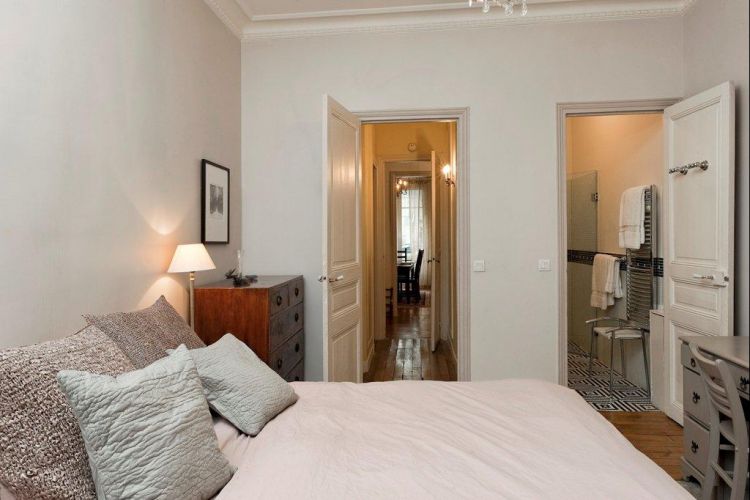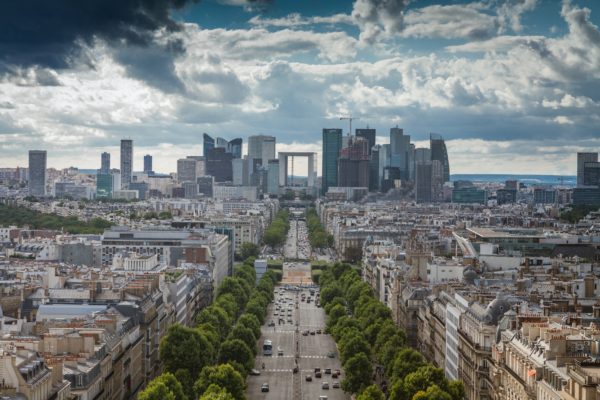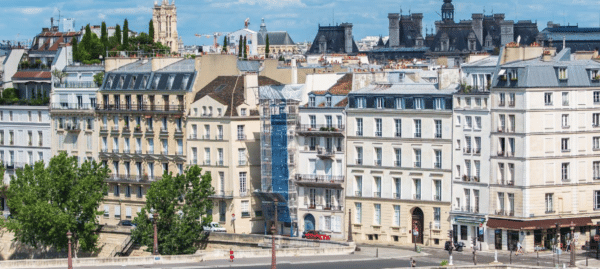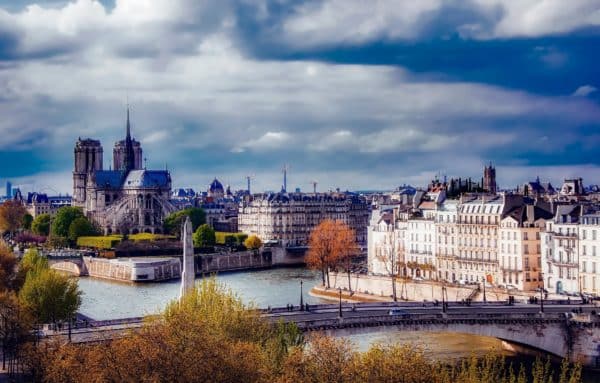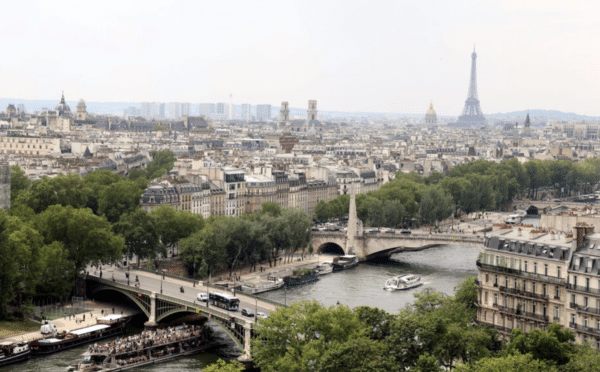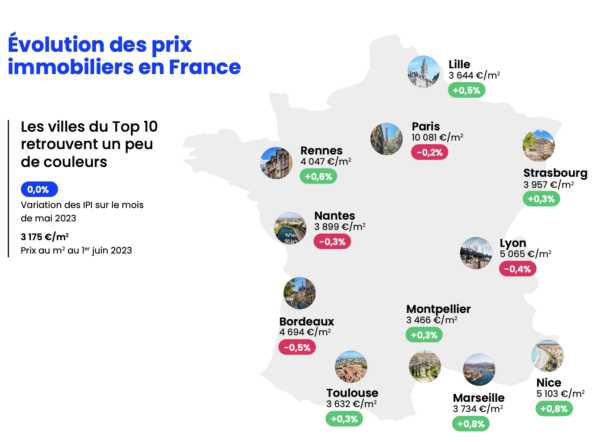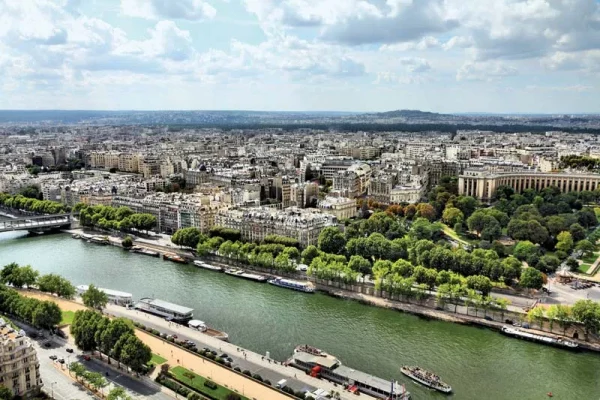|
A Sacred Place
High above the surrounding areas, with thick forest and numerous springs, brought man, as early as the Antiquity, to make this mount a sacred place. This mount, though not yet named Montmartre, became a place of frequent pilgrimages. The Gallic druids came to revere their numerous gods here. The Romans established a temple dedicated to Mercury and there they adored Bacchus, God of the vine. During the Gallo-Roman era, the “Parisians” saw in this haven, then lost in the removed countryside, the perfect place to pray and honor their gods. In fact, the site w
as at a sufficient distance from Lutèce, (the ancient name for Paris), to make it somewhat of an exploit to get there. The rich merchants in turn found it to be the ideal location to build their homes. They could see Lutece but they were too far away and well beyond the woods and marshes to be bothered.
The Legend of Saint Denis
If the numerous forests and springs had brought the Gallic and the Romans to make this mount their favorite place of worship, centuries later its religious vocation would be confirmed due to the wealth of its limestone subsoil. In fact, the numerous excavations dug by men capitalizing on theses quarries would later be used as a hideout for the persecuted Christians looking for a place to pray. Saint Denis, first bishop of the region, would have even carried out his first evangelizations here. Arrested, then tortured, he apparently died decapitated, never denying his faith. The legend relates that, guided by an angel, he traversed the mount, his head inhis hands, to his burial ground. The mount, until then called the “Mount of Mars” or the “Mount of Mercury”, eventually took the name “Mount of Martyrs”, and the name Montmartre was derived from it. Near the end of the fifth century, a basilica was erected on the place where the remains of St. Denis rest. And Montmartre, until then a sacred place, became a frequent destination for pilgrimages. |
|
| The abbey of the Abbesses |
| In 1133, the king Louis VI – fervent Christian devoted to Saint Denis – decided to establish an abbey for women on the mount of Montmartre, which over many centuries, had become a meeting place for the pilgrims. Thus, until the French Revolution, the mount would preserve this function. The king did not build this structure only to please his beloved spouse, but rather to serve penance, and repurchase his soul, as he deemed himself responsible for the bloody religious battles, that only political reason seemed to justify. Forty-six abbesses directed this abbey through the breadth of the centuries that followed, and lived many happy lives, and some, tragic destinies. Mary of Montmorency Laval was the last abbess. Victim of the deadly madness of the revolutionary period, she was accused in July 1789 of hiding soldiers, weapons and munitions in her abbey. Declared “enemy of the people”, in an era where terror took over from reason, she was guillotined. The abbey was pillaged and the furniture sold at auction. Its church – Saint Peter’s – miraculously escaped the devastation and is the oldest church of the Isle de France today. |
 |
|
|
|
| The Sacred Heart |
| In 1870, France was conquered by Prussia. The siege of Paris, which lasted four months, provoked famine and misery. The Catholics saw in this signs of divine punishment. Since the Revolution, weren’t the impious in power? Many pilgrimages and public prayers were organized. The safety of France could only come from the consecration of the Sacred Heart of Jesus. It was necessary to do penance and build a temple in his honor. Montmartre was chosen because of its religious past and its dominating position above Paris. In 1873, the National Assembly voted in a law declaring the usefulness of public works. The project of the architect Paul Abadie — who preferred the Byzantine curves to the neo-gothic styles — was selected. However, the beginning of the work was a true challenge because so many quarries had been dug that no one knew how to support such a monument. The foundations had to be deeper than those of the Egyptian pyramids! More than forty years of labor and a budget seven times the initial one were necessary to accomplish this Roman-Byzantine masterpiece. Built with a rock that has the characteristic of hardening and whitening with time, finished on the eve of the First World War, the long awaited consecration of the Sacré Coeur took place only 5 years later on October 16, 1919. |
 |
|
|
 The Town of Montmartre The Town of Montmartre |
|
In medieval France, the towns were traditionally constructed around the church where the peasants came to look for protection and refuge. Montmartre developed in a very different manner. In fact, the town followed the rhythm of the life of the abbey of the Abbesses, established in 1133. The nuns, over many centuries, suffering from the hazards of wars or economical difficulties, had to sell the land belonging to the abbey, in order to pay their debts and indeed to survive. This is how little by little, the sacred hill saw its agricultural vocation born. First established was the cultivated vine, then the farms and the mills. It was only under the Second Empire that the appearance of the mount of Montmartre truly changed. As the Baron Haussmann built his grand boulevards in the Paris that we know today, he brought the expropriated Parisians to settle in Montmartre where the rents were much lower. The deep countryside then began to transform itself into more of a suburb, then a city.
|
|
| The Quarries of Montmartre |
| As early as Antiquity, the subsoil of Montmartre, very rich in gypsum and in chalk, was abundantly exploited to build Lutèce, and then Paris. An old saying even states that “there is more Montmartre in Paris than of Paris in Montmartre”. The gypsum became so famous that it was even exported to England and America. The true metamorphosis of the neighborhood was directly linked to these quarries, or rather to their closing. The quarries served as refuge to outlaws and vagrants and it was in fact quite dangerous to walk there at night. In about 1830, all exploitation was stopped because the continuous hollow ground rendered itself dangerously unstable. The threats of collapse brought the authorities to forbid all underground exploitation. Thus, little by little, this disturbing underground population disappeared, and the town gained in security. When in 1860, Montmartre was joined to the city of Paris, it retained the aspect of a provincial town. All this would change as the bohemian Montmartre would soon see the light of the city. |
|
| The Bohemian Life |
 |
Probably more attracted by the modest price of the rents than by its picturesque mount, Montmartre very quickly became the rendez-vous of artists. Painters, sculptors, writers and poets were among the first to settle here. Among the most famous, were Augustus Renoir, Gérard of Nerval, Utrillo, Cézanne, Toulouse-Lautrec and Picasso. It was the era of the “washhouse” or true camaraderie. Times when one and all – penniless — traveled the streets of Montmartre in quest of a served dinner in exchange for a picture or a poem. Late at night all would meet again at the “Lapin Agile” where they knew that the owner, the old Frédé, and his wife Berthe, would not let them leave with empty stomachs. They ate, drank, sang, laughed, and often fought, as the wine flowed. Then they would dance ’till the wee hours at the “Moulin de la Galette”. Little mattered…… the atmosphere of Montmartre was created, a mood of frank fellowship, where all “stuck together” while awaiting better days. |
|
| Even if today’s Montmartre has become popular with tourists, it has not lost its charm of long ago. When one strolls along its slopes, one always rediscovers with the same pleasure its bohemian atmosphere. You can still have a meal at the “Moulin de la Galette” (Lepic Street), or return to the corner of Saint Vincent and Saules Street, to the “Lapin Agile” where the cartoonist André Gill drew the sign — a rabbit jumping from a saucepan, thus giving the restaurant its name. After having climbed the numerous steps to the summit of the mount, it is very pleasant to discover one of the most beautiful viewpoints of Paris, to stroll Places du Tertre or in the small adjacent streets, such as the beautiful Junot Avenue a little lower, and to discover the secret charm of the Victorian Villa Léandre. You may even come upon one of these poets or painters that will propose his creations. And why not descend to the foot of the mount and push open the door to the Moulin Rouge? Ah! We must save that for another day… |
|
|
 |
|
